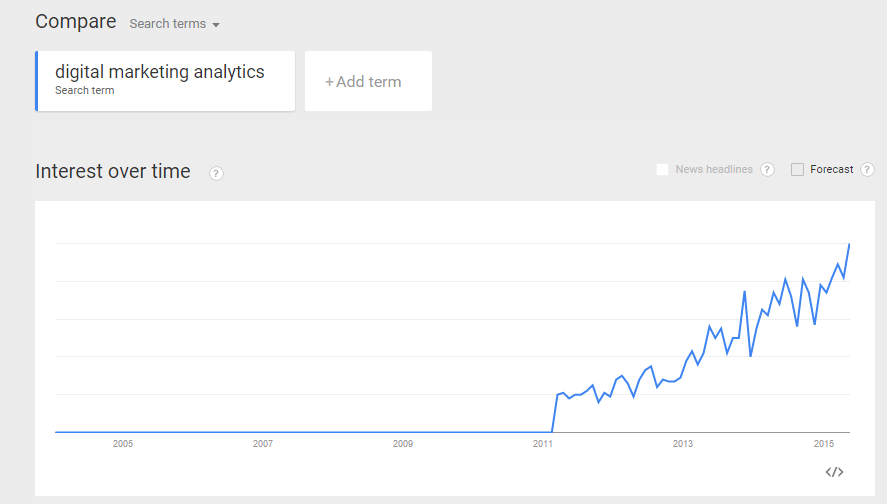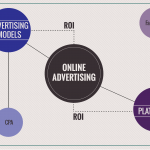Digital Analytics: redefining business performance

In the digital world, the need to better understand marketing actions has generated the apparition of a new concept: analytics. One year after Forbes proclaimed 2014 the year of the analytics, the importance of the discipline has not dropped one bit: with the ever increasing role of the digital element in our lives, marketers continue to require insights into what the impact of their campaigns is, how users respond to marketing messages, or how often websites are visited, and so on.
A good indicator of how the concept of analytics has grown in importance is revealed by simply looking at Google Trends: after first appearing in search queries in 2011, the volume of searches surged in 2013, and continued to grow sharply after that.
The definition
So, what are digital analytics?
The concept was defined in a comprehensive manner by Avinash Kaushik, author of Web Analytics 2.0 and Google Analytics evangelist: “Digital analytics is the analysis of qualitative and quantitative data from your business and the competition to drive a continual improvement of the online experience that your customers and potential customers have which translates to your desired outcomes (both online and offline).”
The definition stresses the fact that, for a business to reach its desired outcomes, it needs to continually improve the online experience of its customers and potential customers. The best way to do this is to look at what is already happening both within the own business and within the competition’s business and analyze the data to reach conclusions that would guide managers in their decision making.
Although used interchangeably, digital analytics and marketing analytics have slightly different meanings. HubSpot reveals what marketing analytics refers to: “Marketing analytics go beyond measuring strictly online performance, favoring a more holistic approach to the measurement of marketing efforts. By connecting all areas of marketing, including offline efforts, with sales and lead generation results, marketing analytics reveal the direct impact marketing has on pipeline generation and revenue growth.”
The challenges of diving into analytics
Although the importance of analytics surged in the past years, there are plenty of business owners who can’t grasp what the impact of not looking into data really translates into. Websites and campaigns are no longer about the brand, they are about the client. Approaches which fail to dive deep into the numbers that show how a user behaves on a website, or in relation to a certain campaign are soon to be forgotten.
Additionally, marketers who have just started using analytics have the tendency to look more into what are called vanity metrics: visits to the site, page views, number of newsletter subscribers, followers on social media, bounce rate, or time spent on your site. While this may be useful for giving a broad idea on what is happening, these numbers alone fail to deliver a comprehensive image of how the business performs. Neil Patel suggests looking at other metrics too:
- who visits the business site
- what are those people doing once they get there;
- what channels are driving buying customers;
- who is converting;
- what conversions are deepening relationships;
- what conversions are driving revenue; who is buying multiple times;
- what’s a lifetime customer’s value.
Another challenge is related to the existing tools that aren’t always real analytics tools, but rather they are automation tools with a little tracking, as mentioned by Hausman in her article, “An Insider’s Guide to Digital Marketing Analytics.”
To make the right choice, a marketer needs to test the functionalities of different tools to see if the insights they provide are satisfactory. But a great fallback, in case there are too many options to choose from, is Google Analytics. The complexity of this tool goes beyond the simple measurement of website traffic and bounce rate, allowing marketers to measure how their campaigns are performing. And what channels are the ones the audience better responds to by driving more traffic to the website.
Addressing challenges
When it comes to solutions for the challenges of diving into analytics, a straightforward approach consists of raising awareness and developing skills.
First of all, business owners need to be aware of the importance of analytics and understand that their business needs to focus on the user. Naturally, the best way to do this is gaining actionable insights from the business and from competition, through data analysis.
Secondly, nothing can be done without the expertise of the analytics savvy marketers. Fortunately, the analytics tools, like Google Analytics, as well as marketing automation software like HubSpot, all provide educational support for understanding and using them. Take, for example, the invaluable training offered through the Google Analytics online course. To take full advantage of it, one first needs to learn about all the ways in which it can be used, how to properly implement it, and only then link their websites to the tool.
Last but not least, deriving from the awareness of business owners and skills acquisition of marketers, the most effective and actually, the only reasonable way of implementing analytics is by building a plan that takes the business model into account. The next step is to develop a set of metrics that best reflect the business model in discussion: look at the business strategy and derive KPIs (Key Performance Indicators) from it. The indicator selection should include metrics that are placed at the initial stages of interaction with the client, such as reach, engagement, but also the later stages of interaction, such as conversion rate, or ROI.
After proper implementation is completed, it is good to keep in mind that this was only the first part of the journey. As Avinash Kaushik says, analytics helps at driving “continuous improvement” of the client’s experience with the business. As for any improvement process, the data that is gathered and processed will lead to actions which, in turn, will lead to results that need to be measured and analyzed and so on. Thus, the cycle has just begun to enfold.
References:
- Mawhinney, J, (2014), HubSpot, Marketing Analytics vs. Business Analytics: What’s the Difference (And Who Should Care)?
- DeMers, J., (2014), Contributor Forbes, 2014 Is The Year Of Digital Marketing Analytics: What It Means For Your Company
- Kaushik, A. (n.d.), Rethink Web Analytics: Introducing Web Analytics 2.0
- Patel, N. (2012), Measuring what matters (with Neil Patel from Kiss Metrics)
- Hausman, A. (2015), An Insider’s Guide to Digital Marketing Analytics
- Google Trends, Digital Marketing Analytics
Image sources:

Tags: Digital marketing performance, Marketing performance, Predictive Analytics






